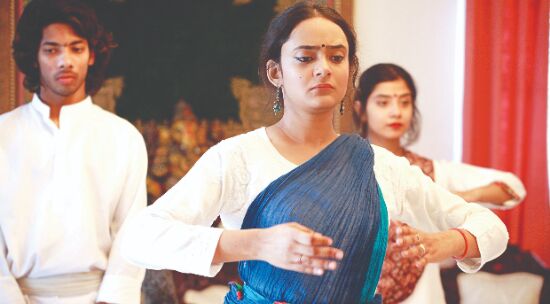Aavartan: A poignant tale of passing on the traditions

Hindi feature films relating to classical artists and their art are rare. One of the first was the 1952 black and white movie 'Baiju Bawra' that dealt with the life of the great singer Nayak Baiju. As such it was a pleasant change to view 'Aavartan', a nearly two hours offering by writer-director Durba Sahay. The word 'aavartan' refers to a cycle or rotation, a term commonly used in the classical music and dance lexicon. In the context of the film, it refers to the cycle of 'parampara' (tradition).
Dealing with the life of a middle-aged dancer at the peak of her success, the main focus is on the relationship of the Guru Bhavna played by Kathak dancer Padmashri Shovana Narayan and her star pupil Renuka, played by Kathak dancer Mrinalini. Despite nurturing her talent, when the younger dancer starts to upstage the older, the conflict inherent in the situation is poignantly depicted. Any performing art needs an audience and sharing this even with one's disciple is a challenge.
Sushma Seth, who gracefully plays the role of Shovana's guru, is shown as leaving her daughter to work through the conflict herself. Her unspoken advice, on the inevitability of a new generation coming up and the passing on of a tradition, is through the gift of a precious 'ghungroo' given to her by a doyen of an earlier era. Saying 'this is the most precious thing I have left today; I am now handing it to you for safekeeping, to be treasured and passed on in turn by you,' Seth gives her advice obliquely, hinting at the inevitability of change.
Though this is their first film, Mrinalini and Shovana Narayan are convincing. The competitive arena of the arts and the importance of media coverage of performances are all realistically portrayed. Sunit Razdan is as recognisable as the devoted manager who has to deal with his egotistical dancer boss. In one tongue-in-cheek scene, she imperiously asks him how a critic hostile to her and managed to enter the hall to view her performance!
While the film in every way is totally realistic and brilliantly depicted, one crucial scene leaves one wondering. At the disciple's debut performance sharing the stage with her guru, the guru's 'ghungroos' break and she leaves centre stage to fix them. At this point, the disciple takes over, moving into the spotlight and continues till the end of the 'aavartan', not noticing that her guru was ready then, in the side wings, to resume her position.
Shovana is shown visibly discomfited, which one wonders at a seasoned dancer like her would surely not have revealed her chagrin to her audience. The viewers are left wondering whether the disciple indeed intended grabbing the limelight, as her guru believes or whether it was the instinctive training of a professional to cope with the unexpected on stage. This scene is a turning point in the film.
The clips of actual live performances of Shovana Narayan are a delight. Indeed, the film is so realistic that one has to remind oneself that it is not a biopic of Shovana Narayan. The careful juggling between the dance and the film is skillfully handled by Sahay. Mercifully, the dance itself is treated matter-of-factly, without overly glorifying the tradition. This is a must-watch for anyone interested in the arts.



